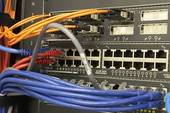
New SuperSpeed USB 3.0 Finally arrives.The beauty of USB 3.0 is its backward compatibility with USB 2.0; you need a new cable and new host adapter motherboard that supports USB 3.0, but you can still use the device on a USB 2.0 port and achieve typical USB 2.0 performance. In reducing some overhead requirements of USB (now, the interface only transmits data to the link and device that need it, so devices can go into low power state when not needed), the new incarnation now uses one-third the power of USB 2.0.
The theoretical throughput improvement offered by USB 3.0 is dramatic -- a theoretical 10X jump over existing USB 2.0 hardware. USB 2.0 maxed out at a theoretical 480Mbps, while USB 3.0 can theoretically handle up to 5Gbps. Mind you, applications like storage will still be limited by the type of drive inside; so, for example, you can expect better performance from RAIDed hard drives or fast solid-state drives (SSDs) than from, say, a standalone single drive connected to the computer via USB 3.0.
USB 3.0 performance was on a par with eSATA but the benefit here is that it don’t need a power port, so you don't need to have another external power supply running to the drive












